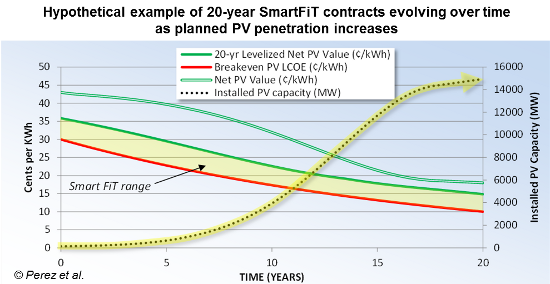As effective as FiT programs have been in promoting solar in countries such as Germany and Spain, they have sometimes become victims of their own success, leading to boom/bust cycles and political targeting. The SmartFiT is an alternative solution that has the potential to overcome the weaknesses inherent in today’s FiTs.
Since the early days of solar, society has helped pay for deployment of this technology, which is more expensive than conventional energy generation. Why? Because of the belief that solar energy brings more value to the table than can be monetized via business-as-usual energy markets. Additional value from solar comes in the form of environmental benefits, long term energy security, increased economic development, and effective peak shaving capacity.
Today financial support mechanisms vary widely, from retail electricity pricing (net-metering), buy-down grants, solar renewable energy credits (SRECs), and local and federal tax credits and deductions in the U.S., to cost recovery feed-in-tariffs (FiTs) adopted in much of the rest of the world. Gauged by the amount of photovoltaic (PV) systems installed in the world, the FiT model has been very successful, with more than 80% of installations deployed under FiT programs.
In simple terms, the FiT model levelizes the playing field by providing above-market energy purchase rates high enough to enable solar deployment. On the face of it this seems pretty straightforward. However, because FiTs have traditionally been based on the cost of the renewable technology, many question the rationale of preferentially subsidizing the most expensive technologies (i.e., solar over wind). Additionally, the lack of adequate market controls has led to overbuilding, which has in effect ended the thriving solar market in Spain, and drastically reduced the value of SRECs(1) in New Jersey and Pennsylvania.
I’ve been working with a group of industry experts(2) to understand this phenomenon, and together we’ve come up with an alternative solution that has the potential to overcome the weaknesses inherent in today’s FiTs. We call it the SmartFiT.
The SmartFiT model is formulated from the onset to quantitatively link fair, value-based remuneration to PV energy. It retains the core effectiveness of the FIT and the keys to its success, namely: simplicity of interconnection and long term energy production contracts. But the SmartFiT model removes weaknesses which have been at the root of several visible PV market boom/bust crises, and which make FiTs and other incentives political targets.
This is achieved by directly linking the SmartFiT to the value PV brings to the table, and that accrues to both ratepayers and society at large (i.e., taxpayers). Importantly, this value depends upon key underlying factors that are generally not considered by current remuneration systems, including:
- Location – Depending on location, PV generation can either support the grid by relieving congestion and contributing to peak shaving, or, in extreme cases, do the just the opposite. For example, a commercial PV system in a congested metropolitan area has a much higher ratepayer value than a system interconnected in a low congestion area, or where peak energy use is at night.
- Penetration/saturation – As PV penetration increases, the decongestion, peak shaving, electrical loss savings and market price reduction value produced by PV tends to erode, and the cost associated with large scale integration (e.g., load management, storage, and interconnection) tend to augment.
- PV system specs – The tilt and orientation influence a system’s ability to peak shave and deliver capacity value. More importantly, system attributes such as dispatchable and/or emergency storage can have a high load management and/or resilience value by keeping businesses operational during power outages caused by weather or stressed power grids.
The SmartFiT reflects these value-relevant factors and evolves with them. As such, it contributes to fostering PV deployment where most needed, promotes high value systems, and facilitates very high penetration. At the same time the SmartFiT should be informed by current PV levelized cost of energy (LCOE) and should not exceed it by too large a margin so as to avoid overbuilding and resulting market rushes and contractions.
Ideally planners should set the SmartFiT at the minimum between a system’s LCOE with an acceptable ROI, and its levelized delivered value, as illustrated below:

Finally, we believe the SmartFiT should embrace effective PV deployment practices that have been successfully pioneered in the U.S. and abroad: in particular, a virtual component that allows PV investors (developers or homeowners) with poor development sites – from either low value location or high field of view obstructions – to have the opportunity to invest in a more appropriate high value/low obstruction sites. Ideally this option would allow investments to be aggregated among several owners following a Solar Garden model.
For an in-depth look at the SmartFiT method, read the Solar Today article: “Why a Smart FiT Is Smart Policy” (pages 18-21 of the Jan./Feb. 2013 issue).
Richard Perez is a research professor at the University of Albany’s Atmospheric Sciences Research Center. He sits on the board of the GW Solar Institute at George Washington University in Washington, D.C. He has produced more than 200 journal articles, conference papers and technical reports, and holds two U.S. patents on load management using photovoltaics. Richard developed the industry’s leading satellite-derived irradiance models, the output of which is available in Clean Power Research’s SolarAnywhere® product. He holds a doctorate in atmospheric sciences from the University at Albany.
________________
(1) Of course SRECs are not FiTs, but the cases of NJ and PA illustrate what can happen when too high a retribution results in a short boom followed by a longer bust.
(2) Tom Thompson, New York Solar Energy Society; Tom Hoff, Clean Power Research; Lyle Rawlings, Advanced Solar Products; Ken Zweibel, GW Solar Institute, George Washington University; Pradeep Haldar, College of Nanoscale Science and Engineering, SUNY Albany; Rick Lewandowski, Direct Gain Consulting.
